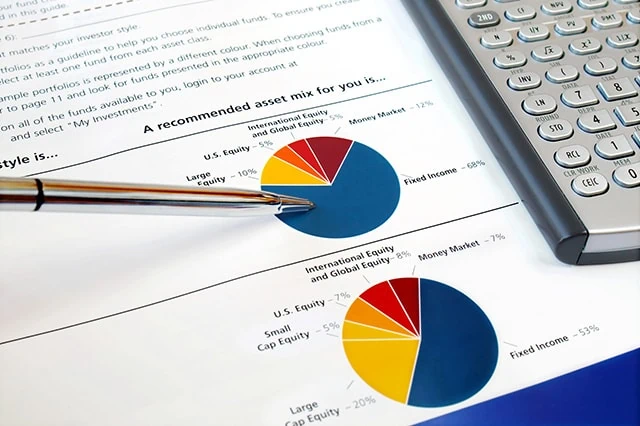We, along with the rest of the financial media, spend a lot of time talking about the importance of growing your money. But accumulating wealth is just one step to becoming financially stable—equally as important is protecting your wealth.
To be clear: I don’t mean hiding cash in a wall safe or setting up an elaborate system of booby traps around a piggy bank.
No, preserving your wealth involves careful planning, smart decision-making, a little discipline … and understanding which actions can do the most to keep your financial worth intact.
Let me show you what I mean. Read on as I discuss some of the best ways to keep your nest egg from cracking. By implementing some (or all!) of these strategies, you’ll put yourself in a much better position to keep what you’ve earned.
Featured Financial Products
Table of Contents
Start These Wealth Preservation Strategies Now

One thing we probably can all agree upon is that it’s much easier to lose some of your net worth than it is to make it grow.
However, while building your wealth takes a lot more work, protecting it takes a lot more care and caution.
That’s another way of saying that some of the most effective ways to protect your money fall under the “work smarter, not harder” umbrella. all probably agree upon Most people likely agree that it’s much easier to lower one’s net worth than to increase it. I don’t want your life savings to seemingly slip through your fingers like sand. These are the actions you need to take to maintain, or even grow, your wealth.
1. Diversify Your Investments

Diversification is investment-speak for not putting all of your eggs in one basket. And diversifying your investments is one of the most impactful things you can do to achieve a balance between risk and reward.
For example: Let’s say you put 100% of your investment money into Corporate Inc. stock. If that stock goes to zero, your nest egg is gone. Now let’s say you only put 1% of your funds into Corporate Inc. stock, and did the same for 99 other stocks. If that same stock goes to zero, sure, the worth of your portfolio will decline—but the most you would lose is 1% of your funds!
Owning a larger number of investments is one way to diversify. But there are many others that you can utilize to achieve an ideal balance of return and risk:
— Asset diversification: You can own assets other than stocks. Bonds, for instance, have much different investment characteristics—whereas stocks provide growth but also higher risk, bonds have less upside potential but can deliver income and stability. Alternative investments (those outside stock and bonds) have their own pros and cons.
— Style diversification: If you hold nothing but growth stocks, you might significantly outperform the market—but you could also be subject to wild swings in the worth of your portfolio, triggering you into making rash decisions. So you might consider holding, say, a mix of growth and value stocks, as the latter often offers higher dividend income, stability, and even outperformance in difficult markets for growthier firms.
— Sector diversification: If you own 100 stocks, but every one of them is in the energy sector, your whole portfolio will more or less be at the whims of prices in commodities such as oil and natural gas. However, by spreading your exposure across different sectors—which represent different areas of the economy—your whole portfolio won’t be beholden to just a handful of industry trends. Plus, different sectors tend to have different risk-reward compositions.
— Geographic diversification: OK, so, the U.S. has historically been one of the best places to invest your money. Having a portfolio that’s 100% allocated to American companies wouldn’t necessarily be the worst thing in the world, in part because many large American companies are actually multinationals whose success hinges on performance in many other countries. But you also never know. Investing in other parts of the world is seen as a way to hedge against any weakness in the U.S., and depending on which markets you’re investing in, a way to invest in countries with much higher rates of economic growth.
If you want to diversify your portfolio, you’ll want to become familiar with investment funds, which include mutual funds, exchange-traded funds (ETFs), and closed-end funds (CEFs), among others.
An investment fund will hold hundreds or even thousands of stocks, bonds, and other investments—and all it takes is a single buy order to gain exposure to these holdings.
That’s a much more attractive proposition than trying to build and manage a portfolio of thousands of holdings all by yourself. Plus, funds are more cost-effective—you might spend $20 or $30 to buy a share of a fund holding 100 stocks, but you might spend thousands or even tens of thousands of dollars to buy all those stocks individually.
Alternatively, you could have a financial advisor construct a diversified portfolio for you, then manage those investments over time.
Related: Do These 10 Home Renovations Before You Retire
2. Diversify Your Income Streams

The same wisdom can apply to your income sources.
Earlier in your life, when you’re young and energetic, you might consider supplementing your income from a primary job with a side hustle. This isn’t an overt blessing of hustle culture—it’s certainly not for everyone, and there are clear downsides from overworking yourself—but having multiple income streams can help you accelerate your savings and partially cushion you from the loss of a job.
It’s also helpful to have multiple sources of income once you’re ready to call it a career.
Most people will enter retirement with at least two income streams: Social Security benefits, and withdrawals from at least one tax-advantaged retirement plan.
However, it might help to have multiple retirement plans with differing tax advantages, such as a traditional IRA (taxes aren’t paid until you withdraw) and a Roth IRA (funded with already-taxed money, but you don’t take out taxes when you withdraw).
Additional income streams—such as a pension, life insurance policy, settlement, even a part-time job—can help reduce the risk of any one source of money running dry.
Related: 7 Best High-Dividend ETFs for Income-Minded Investors
3. Account for Inflation

Inflation eats away at the value of your money. Consider this: In the year 2000, you purchased an item for $100. If that item’s price rose at the same rate of general inflation, that same item would cost $182.81 in 2024.
The problem is, there’s no stopping inflation—there’s nothing you, nor I, nor anyone else can do to halt the march of rising prices.
But we can (and should) invest with the idea of rising prices in mind.
Near the end of 2024, data from the Federal Reserve Bank of Cleveland showed that inflation over the next 10 years was expected to average 2.3%. If that came to pass, that would mean if you left $10,000 in cash under your mattress, that cash would lose 2.3% of its value every year. So, if you wanted your money to at the very least maintain its value, you’d want to invest it in something capable of delivering at least 2.3% growth per year—say, a high-yield savings account (HYSA) or a certificate of deposit (CD).
Dividend investors sometimes invest with inflation in mind, too. The most obvious solution would be to look for companies with yields higher than the rate of inflation. But you need to understand that inflation can erode your dividends’ spending power, too. If you hold a $100 stock that pays $1 per year, and it continues to pay $1 per year for 10 years, your dividend income is actually losing ground to inflation every year. So if you’re evaluating dividend stocks, consider prioritizing names with a track record of inflation-beating dividend growth, and that you believe will continue to hike its payout at a rate higher than inflation. This can help ensure your dividend income at least keeps up with (if not surpasses) inflation over time.
Lastly, factor in inflation as you budget for retirement. For instance, you might currently live comfortably on an annual income of $80,000, so, using the 80% rule, you’d project that you’d live comfortably on $64,000 per year in retirement. But if you’re decades away from retirement, inflation could greatly increase the headline income number you need to hit.
(Note: Everything I’ve said above applies for money you won’t need in the very short term. It goes without saying that you need some money in a checking account to deal with your everyday expenses, even if that money doesn’t earn a cent of interest.)
Related: Stop Shrinkflation! 10 Products Affected + Tips to Save Money
Featured Financial Products
4. Be Tax-Smart

The more strategic you can be about using the tax code to your advantage, the less money you have to fork over to Uncle Sam.
The investment world provides a wealth of opportunities:
— A tax-deferred account, such as a traditional 401(k) or IRA, allows you to contribute pre-tax dollars (reducing your taxable income), allows your investments to grow tax-free, and allows you to withdraw the money in retirement at a potentially lower rate than you would’ve paid when you contributed that cash.
— A tax-exempt account, such as a Roth 401(k) or IRA, is funded with money that has already been taxed, but it too allows investments to grow tax-free, and you generally won’t have to pay taxes when you withdraw that money in retirement.
— Health savings accounts (HSAs) use pre-tax contributions and allow funds to grow tax-free. Plus, withdrawals aren’t taxed (at any age!) if they’re used for qualified medical expenses. (You can also withdraw funds for any purpose once you reach age 65; you’ll be taxed, but you won’t face a penalty.)
— Did some of your investments fare poorly this year? You can use tax-loss harvesting to turn disappointing portfolio holdings into tax savings.
You have myriad other options for using tax planning to protect your wealth outside the investment space.
One for instance: If you want to sell your house for a gain but have lived there for under two years, you might consider waiting until you reach that two year mark. Why? The tax code allows for you to exclude up to $250,000 in capital gains on the sale of your home ($500,000 for married filers). In recent years, several new homeowners locked in low mortgage rates prior to a rapid increase in interest rates to stem the effects of inflation. Many of those homeowners may now qualify for this gain on sale of home exclusion, saving potentially thousands of dollars.
Another real estate-related tax-smart move: taking advantage of the “Augusta Rule” that allows homeowners to rent out their primary residence for up to 14 days per year tax-free. If you’re comfortable with having guests rent your home while you’re away, this can be an easy way to earn tax-free income.
Related: New Capital Gains Tax Rates for 2025 Are Now Available
5. Have Adequate Insurance

Having insurance is a calculated risk—one that largely guards against awful-case scenarios. It’s possible that you’ll pay for insurance for years and come up a little financially behind for it—but it’s also possible that you come out a little ahead or, in some circumstances, save yourself from financial ruin.
Take health insurance, for instance. Health insurance is one of the biggest withholdings from your paycheck, amounting to hundreds, sometimes even thousands of dollars each month. But without it, an injury, serious condition, or some other catastrophic health event could send you into serious debt.
Indeed, medical debt is a widespread problem in the U.S. According to leading health policy organization KFF, around 14 million American adults owe more than $1,000 in medical debt. Approximately 3 million owe more than $10,000. Yes: Health insurance doesn’t guarantee you won’t accumulate some medical debt, but it can significantly improve your chances.
Here are some other popular types of insurance—some of which are often mandated, and some of which are optional—that can help you protect your wealth:
— Homeowners/renters insurance
— Auto insurance
— Umbrella insurance
— Life insurance
— Disability insurance
— Long-term care insurance
Again, the hope here is that you’ll never need to use your insurance. But if something goes wrong, you’ll be glad you were covered.
Related: Retired But Too Young for Medicare? Health Insurance for Early Retirees
6. Have a Hefty Emergency Fund

You can think of an emergency fund as another form of insurance.
An emergency fund, as the name implies, is a bucket of money set aside for something—typically an emergency—that you don’t budget for. Your car breaks down and requires an expensive repair. Your refrigerator bites the dust. You have to fight off a hyperaggressive groundhog infestation.
It also can be used to pay for everyday expenses in the event you’re laid off or otherwise suffer a loss of income.
If you have an emergency fund, you can pay for the necessary expenses and never look back. If you don’t? Well, you might end up having to pay for it with a credit card or a high-interest loan, making the emergency far more expensive than it otherwise would have been.
Experts typically recommend keeping at least three to six months’ worth of regular expenses in your emergency fund. And per our inflation advice above? You can keep this in an HYSA or money market account, both of which are liquid enough to provide immediate access to your money, but still will earn you a few percentage points of annual yield.
Related: Should I Pay Off My Mortgage Before I Retire?
Featured Financial Products
7. Monitor Your Accounts

Another way to protect your wealth is to make sure no one is actively stealing it.
Regularly check your financial accounts and credit reports. American consumers reported losing more than $10 billion to fraud in 2023 alone, says the Federal Trade Commission (FTC). And imposter scams were the most prominent category.
You might have most of your bills on autopay for convenience, and there is nothing wrong with that, but you still need to check your credit card bills and bank account balances to ensure you aren’t improperly being charged for goods or services.
Additionally, check your credit report regularly (you can do so for free once a year at annualcreditreport.com) to ensure no accounts have been fraudulently opened in your name. While you’ll rarely be held financially liable for such things, these accounts could weigh on your credit score, costing you money in the form of higher interest rates on products such as mortgages and auto loans.
Related: What’s the Standard Deduction for 2024 + 2025?
8. Avoid Lifestyle Creep

Congratulations! You got a raise. Now you can stop living paycheck to paycheck … right?
Well, if you exert some self-control, yes. If not, you’ll fall victim to “lifestyle creep” (or sometimes called “lifestyle inflation”), which is when you increase your spending in tandem with your available income.
It can be a slow process—sometimes so slow it’s difficult to even notice. Maybe you had food delivered once per week, but after you got a raise, you celebrated with an extra time. Then that became the norm. Then it slowly moved its way up to three weeks.
But it can also be abrupt. You get a raise, so you go out and buy a better car with a commensurately higher monthly payment.
The problem is, of course, that lifestyle creep takes newly available money that you could be saving and sends it right back out the door. Indeed, this is how seemingly very well-to-do individuals with high-compensation jobs can still feel poor.
The best way to avoid lifestyle creep? Create and follow a budget, and prioritize savings—not spending—every time you redo the budget to account for any raises or bonuses.
Related: States With the Highest Minimum Wages [How States Stack Up in 2024]
9. Have a Plan for Transferring Your Wealth

“You can’t take it with you,” or so the saying goes. Truth is, you just can’t protect your wealth forever.
But you can protect your and your family’s legacy, and ensure that your wealth is intelligently passed on to your family, your friends, and/or your most cherished causes.
The best way to ensure your wealth goes where you intend is to create an estate plan. This includes writing a will, setting up trusts, and establishing gifts to charities, among other tasks. It also usually involves determining the most tax-efficient ways to pass on this wealth to maximize the money you’re leaving behind.
While estate planning may seem only necessary for ultra-wealthy individuals, people of varying socioeconomic statuses should consider it. Having a plan can give you peace of mind and make the financial transition easier for your loved ones and causes.
Related: 7 High-Quality, High-Yield Dividend Stocks
10. Talk to a Financial Advisor

Another misconception in the money-sphere is that financial advisors are only useful for ultra-high-net-worth individuals. But in reality, it can be plenty beneficial even for middle-class earners.
A financial advisor can help you with everything above—investing, planning for retirement, estate planning—and more, such as navigating new financial waters amid major life events (marriage, divorce, receiving an inheritance).
Northwestern Mutual’s 2024 Planning & Progress Study found that Americans who worked with a financial advisor saved twice as much money for retirement than people without an advisor. The study also revealed that 79% of respondents with an advisor said they “have a long-term plan that factors for up-and-down economic cycles over time.” Only 38% of respondents without an advisor could say the same.
Indeed, if you had to follow one single step to protect your wealth, choosing a financial advisor—which opens the gates to numerous best practices—might just be the most effective.
Related: Is Your Retirement on Track? Here Are the Average 401(k) Balances By Age
Featured Financial Products
Related: 12 Best Long-Term Stocks to Buy and Hold Forever

As even novice investors probably know, funds—whether they’re mutual funds or exchange-traded funds (ETFs)—are the simplest and easiest ways to invest in the stock market. But the best long-term stocks also offer many investors a way to stay “invested” intellectually—by following companies they believe in. They also provide investors with the potential for outperformance.
So if you’re looking for a starting point for your own portfolio, look no further. Check out our list of the best long-term stocks for buy-and-hold investors.
Related: 9 Best Monthly Dividend Stocks for Frequent, Regular Income

The vast majority of American dividend stocks pay regular, reliable payouts—and they do so at a more frequent clip (quarterly) than dividend stocks in most other countries (typically every six months or year).
Still, if you’ve ever thought to yourself, “it’d sure be nice to collect these dividends more often,” you don’t have to look far. While they’re not terribly common, American exchanges boast dozens of monthly dividend stocks.
Related: 6 Best Stock Recommendation Services [Stock Picking + Tips]

Stock recommendation services are popular shortcuts that help millions of investors make educated decisions without having to spend hours of time doing research. But just like, say, a driving shortcut, the quality of stock recommendations can vary widely—and who you’re willing to listen to largely boils down to track record and trust.
The natural question, then, is “Which services are worth a shot?” We explore some of the best (and best-known) stock recommendation services.
Please Don’t Forget to Like, Follow and Comment

Did you find this article helpful? We’d love to hear your thoughts! Leave a comment with the box on the left-hand side of the screen and share your thoughts.
Also, do you want to stay up-to-date on our latest content?
1. Follow us by clicking the [+ Follow] button above,
2. Subscribe to The Weekend Tea, our weekly newsletter to read more about investing, spending, taxes, and more, and
3. Give the article a Thumbs Up on the top-left side of the screen.
4. And lastly, if you think this information would benefit your friends and family, don’t hesitate to share it with them!





